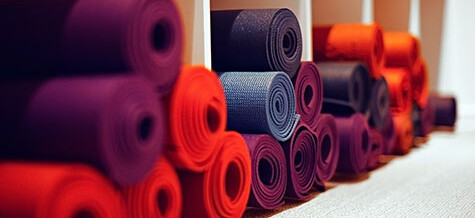
Okay yoga friends, I continue to get questions on which yoga mats are the least toxic and healthiest to use. I’ve had some great comments from many of you and I have done more research. I’m happy to report that my latest research shows that a couple of the mats I recommended in my first post are still on the list! I’ve also learned of some others definitely worth checking out. Criteria were based on possible harmful chemicals used, environmental kindness, comfort and smell since no one wants to be cringing in downward dog, right? Read on!
Of great importance in this post-there are LOTS of articles on “Eco-friendly” “Best Yoga Mat” in terms of traction and “Best Product” reviews, but my focus is on “healthiest” for your/our yoga practices.
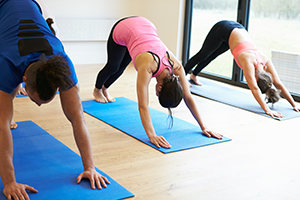
While doing downward dog, who wants to inhale toxic chemicals from our mats?
As a quick recap, many mats are manufactured using PVC, which has been listed by many organizations as the “most toxic plastic” currently used. In addition other toxic chemicals including: phthalates (endocrine disruptors) are added to the PVC to make the mats soft and pliable. Breathing them can cause serious health issues.
Exposure to PVC and phthalates through inhalation and skin contact can result in:
- Damage to the liver, reproductive system, central nervous and respiratory systems. (The Center for Disease Control)
- Cancer – The “gripping” chemicals used in the mats are phthalates which have been shown to cause cancer (LiveStrong.com)
- Obesity
- Worsening allergy and asthmas symptoms
- Other links include heart disease, breast cancer, Type II diabetes (insulin resistant) (Elephant Journal)
-
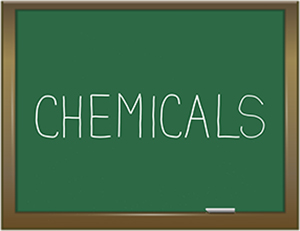
Chemicals used in many yoga mats can create serious health consequences.
Developmental issues (Sarah Novak-Treehugger)
If you’re trying to get pregnant or already are:
- Phthalates in PVC have been linked to: (EcoNovice)
- Reduced female fertility
- Reduced sperm counts
- Malformations of the male reproductive tract and testicular cancer
- Preterm birth and low birth weight
- Phthalates readily pass from mother to fetus through the placenta and have also been found in breast milk
- Possible ADHD in children
If you didn’t catch my earlier post on the health and environmental risks of toxic yoga mats click here.
My Recommended List of Healthier Yoga Mat Alternatives!
*The ones with asterisks indicate they were on my former list and are consistently recommended in all my research. The list is short but alas during research I stumbled on more info that keeps me from recommending certain mats. Pricing is for one size through Amazon for ease of purchasing for those of you with Prime, however companies often offer specials so checkout their sites, too. Prices vary with sizing differences.

Collecting latex from rubber trees is a much healthier alternative to synthetic petroleum-based rubber.
*Manduka eKO Lite ($70)
- Under 5 pounds in weight
- Smell upon opening
- Made from biodegradable, non-Amazon harvested, natural tree rubber
- Free of PVC, toxic plasticizers and foaming agents
- Extremely durable (made of dual layers to provide extra durability)
- Cushion AND grip
- Closed cell construction (means denser support, longer durability and that mats will not absorb sweat and moisture where germs may live)
- Warranty
CONS: Price, return policy (only if “unused” and tags and packaging in place)
To purchase, click Manduka eKO Lite Yoga and Pilates Mat, Sage, 4mm, 68″.
Visit www.manduka.com for more information.
*Barefoot Yoga Original Eco Yoga Mat ($90)
- RATED #1 BY THE NEW YORK TIMES For Environmentally Friendly Yoga Mats
4.5 pounds in weight - No toxic smell upon opening
- Made from all-natural rubber and jute fiber (Jute is a natural vegetable plant that takes only 45 months to grow to maturity, making it a sustainable resource. Jute cleans the air by consuming carbon dioxide, and the leaves are a natural soil conditioner)
- No chemical additives
- A smart and naturally beautiful choice for a cleaner and safer environment
- Highly durable, flexible, natural feeling
- Rubber underside grips the floor while the jute fabric/rubber mix on top offers superb traction – even in a heavy sweat.
CONS: Price, rubber allergies
To purchase, visit visit http://www.barefootyoga.com
MY #1 New Favorite to Add to the list!

Cork is a healthy, natural and renewable resource alternative for yoga mats!
Yoloha Nomad Cork – ($99)
- 2.5 pounds in weight (great for travel!
- No smell
- Yoloha is constructed from anti-microbial, premium grade cork oak trees. (Cork is a natural and renewable resource that is recyclable and also biodegradable and kind to the environment)
- No PVC, plasticizers or latex (all 3 toxic)
- Great for latex allergy sufferers
- Closed cell construction makes it antimicrobial so it’s self-cleaning too!
- Ready to go right out of the box
- This mat gets “grippier” when wet-how cool is that! Especially for you hot yoga enthusiasts! No towel needed
- Any leftovers in the manufacturing process are used to create other new products
- Made in the USA
- The bottom is made of odor-free domestic recycled tires that make for a sturdy mat that lies completely flat and never slides
- Also made at 80” length for you taller yogis
- Lifetime guarantee
- Return within 60 days of purchase date for a full refund
- Great traction and cushy!
- Ethical company-all about sustainability
- 100% recyclable
- Included in purchase is hemp rope carrying strap
CONS: Pricing, no color or pattern variety
To purchase, click Yoloha Nomad Cork Yoga Mat. For more information, visit http://yolohayoga.com.
Why Do Some Mats Smell?
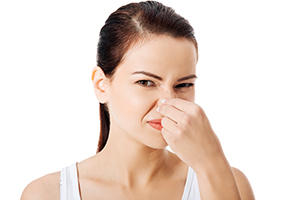
Many yoga mats, including those made from natural rubber trees, come with odors from either chemicals or even rubber trees.
Even if there are no chemicals that are off gassing, natural rubber in particular usually smells. Some last longer but wiping down and airing out help a lot!
How to Get Rid of Mat Smell?
I read several different ways of cleaning one’s mat-hear are a few suggestions but best is to follow the recommended instructions re your mat purchase.
If you have a Natural Rubber Mat:
Air your mat out in a well-ventilated space, draping it over something.
Try to leave it unrolled often. Clean both sides of your mat several times in the first weeks using a mild soap and wet rag to rinse it off. A solution of 50/50 white vinegar and water helps a lot too.
If you have a Cork Yoga Mat:
Use a damp cloth to wipe and clean. Easy!
Important to remember with any mat!
- Be sure not to leave in sunlight as it causes the mat to fade and fall apart.
- Also, avoid using essential oils too as they may break down materials.
Can I throw my yoga mat in the washing machine?
Most of my research indicated “NO.” However I know some who put theirs in a front loader on gentle. Gentle wiping down with warm water and vinegar works well. Some mat companies offer their own spray mixtures, which you can find on their websites. Be sure to read instructions for cleaning when you purchase yours.
Knowledge is Power!
There’s a lot of research out there and it can be a little tricky. The most popular mat for the past 10 years is the Manduka ProLite. It IS a terrific mat but because of its immense durability, the owner of the company has owned up to saying that PVC has been used in creating this mat. In order to bring stability to the PVC for that type of durability there are amounts of heavy metals used. (i.e. lead, arsenic) Do we know how much? Can’t find the answer to that one.

While yoga is a great way to stay fit, be sure your mat isn’t off-gassing harmful chemicals.
That being said, a little knowledge goes a long way and we each have to decide what means the most to us in terms of product. I will remind you that the least expensive mats out there do carry a high percentage of PVC. My daughter runs a hot yoga studio and all of her clients LOVE the Manduka ProLite mat; those mats take a beating in the hot studios, and through LOTS of use. And of course they last a really long time. Money well spent in terms of durability.
I love that the Jade Harmony Yoga Company plants a tree for every mat sold-over one million now. Thanks to Fani for your note re German testing…Yes, unfortunately their testing revealed two carcinogenic materials, nitrosamines and PAHS, in the production of the mats. Also, there has been lack of full disclosure on what “man-made” ingredients go into the construction of their mats.
A couple of companies were inexpensive, claimed, “non-toxic” and “biodegradable” but had TPE or EVA listed as ingredients.
Long-term effects of TPE (thermoplastic elastomers) are not known. According to Wikipedia, TPE (Thermoplastic elastomers) is a mix of rubber and plastic. In other words, TPE is a blend of synthetic materials that have not been disclosed, have not been studied, and have not been proven safe.
Ethylene vinyl acetate, also known as EVA, is an elastic polymer material that is similar to rubber. EVA usually contains no more than 40 percent vinyl acetate by weight, with the rest of the polymer being ethylene. It is resistant to cracks and ultraviolet radiation. EVA is considered to be a safe alternative to PVC, as it doesn’t require plasticizers like phthalates, and it’s BPA free. However, a few years ago it was found that EVA foam contained formamide. Formamide is used to make the foam soft, but it’s considered to be carcinogenic and a developmental toxin.
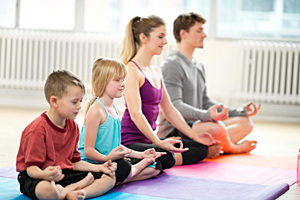
Our little yogis, especially, need healthy non-toxic mats since their bodies and lungs are still developing.
This post may seem heavy with the extra chemical info i.e TPE and EVA but they are listed in a few of the eco-friendly, non toxic mats. I just want you the buyer to beware.
If you have young yogis with still developing bodies and lungs in your house, please be mindful of some of the companies selling mats with TPE or EVA in them too.
Because yoga has become a billion-dollar industry, the manufacturing processes of these materials are sometimes considered a “trade secret.” This means that the toxicity level, carcinogens released during manufacturing, sources & quality of materials, etc. are sometimes not really known, measured or verified.
On the upside, I’m delighted that my current research unveiled the Yoloha Nomad Cork mat. Pricey, but it met all of the criteria for chemical free, eco friendly, no lingering smell and a fabulous alternative for those with latex allergies. And a lifetime guarantee to boot! I’m sold! BTW, that mat has been so popular that it recently sold out on Amazon but is restocking soon!
Remember, don’t throw your old mat away!
Check this out this link. There is some great information on reusing and recycling old yoga mats:
Creative-ways-to-reuse-or-recycle-your-old-yoga-mat/
I hope this information has been helpful if you’re either looking to replace or purchase a new mat. Though we are all budget-minded, please consider non-toxic yoga mats as a wise investment in your overall health.
Namaste!
Peace and Good Health,
![]()
Sources:
Daily Cup of Yoga
DoYouYoga.com
EcoWatch
Rolling Sands
TypeAYoga
YogiApproved.com – Krysta Shannon
If you “Like” this post, I’d be thrilled if you’d share it.
MAR
